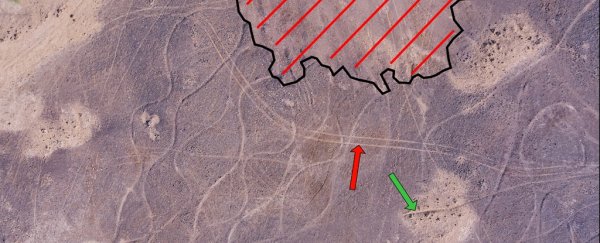Hidden in the vast, arid expanses of India's Thar Desert lie mysterious old drawings carved into the land.
These newly discovered designs are of such immense scale, they were likely never able to be glimpsed in their entirety by those who made them, researchers say.
The huge motifs are examples of geoglyphs – giant hand-made depictions and patterns built upon or carved into the land, often occupying such scope that the true appearance of their forms can only be appreciated from far above.
Amongst all known geoglyphs of historical relevance – including the famous Nazca Lines of Peru – the Thar Desert formations appear to stand alone, however, representing what may actually be the largest-ever graphical depictions designed by humans.
 (Carlo & Yohann Oetheimer, Archaeological Research in Asia, 2021)
(Carlo & Yohann Oetheimer, Archaeological Research in Asia, 2021)
Above: Aerial view of giant spiral (Boha 1) and Boha 2, including the serpent figure in lower-right corner.
"So far, these geoglyphs, the largest discovered worldwide and for the first time in the Indian subcontinent, are also unique as regards their enigmatic signs," researchers explain in a new paper detailing the find.
Discovered by a pair of independent researchers from France – Carlo and Yohann Oetheimer – the new geoglyphs were spotted using Google Earth, during a virtual survey of the Thar Desert region (also known as the Great Indian Desert); this region encompasses some 200,000 square kilometers (roughly 77,000 square miles) of territory overlapping India and Pakistan.
Amidst this huge, dry landscape, the Oetheimers identified several sites located around the 'Golden City' of Jaisalmer, marked by geometrical lines resembling geoglyphs.
Closer inspection during a field study in 2016 using an uncrewed aerial vehicle (UAV) revealed some of the identified sites were furrows dug for tree plantations, but also helped reveal a cluster of enigmatic line formations seemingly absent of trees.
In particular, two "remarkable geometrical figures" of exceptional character close to the village of Boha stood out: a giant spiral and a serpent-shaped drawing, each connected by a cluster of sinuous lines.
The lines that make up these figures are stripes etched into the ground, ranging up to 10 centimeters deep (4 in) and spreading 20 to 50 cm wide (8-20 in). While these dimensions up close may be unremarkable, what they end up making up is not.
 (Carlo & Yohann Oetheimer, Archaeological Research in Asia, 2021)
(Carlo & Yohann Oetheimer, Archaeological Research in Asia, 2021)
Above: Section of giant spiral, seen at ground level.
The largest geoglyph identified, the giant asymmetrical spiral (called Boha 1), is made from a single looping line running for 12 kilometers (7.5 miles), over an area 724 meters long by 201 meters wide (790 by 220 yards).
To the southwest of this huge vortex shape rests a serpentine geoglyph (Boha 2), composed of an 11-kilometer long line, which encompasses a serpent-like figure, a smaller spiral, and a long boustrophedon-style sequence of lines running back and forth.
Other small geoglyphs can also be found in the Boha region (including a feature of meandering lines, called Boha 3), which in total includes around 48 kilometers of still visible lines today, which the researchers estimate may once have extended for about 80 kilometers.
"The giant spiral and serpentine figure are definitely the major points of interest, closely connected to Boha 3, suggesting that all the other geoglyphs were created as a framework for this set," the researchers write.
"Due to their spatial contiguity, patterns 1, 2, and 3 can be perceived as a sequential project."
Just what this project represents, and who created it, is not yet fully clear, but the researchers suggest the formations are not ancient but rather relatively recent geoglyphs, perhaps at least 150 years old; they may also be contemporary with Hindu memorial stones found in the area.
 (Carlo & Yohann Oetheimer, Archaeological Research in Asia, 2021)
(Carlo & Yohann Oetheimer, Archaeological Research in Asia, 2021)
Above: A Hindu memorial stone, located near the geoglyphs, and thought to be part of the contemporaneous cultural context of the lines.
Without definitively knowing more about the identity of their creators, it's difficult to speculate as to the function and meaning of these giant geoglyphs, but the researchers nonetheless have a few ideas.
Given the region is flat, and the makers of these structures would not have been able to take in their creations (which would have required being about 300 meters up in the air), the authors say it's unlikely these designs were intended as a form of artistic expression contemplated from the ground, but rather might have served as an unknown type of cultural practice in their making.
"[This] invites us to consider religious, astronomical, and/or cosmological meanings," the researchers say.
"Because of their uniqueness, we can speculate that they could represent a commemoration of an exceptional celestial event observed locally."
While there's a lot we don't yet know about these mysterious marks and their semantic relationship to each other, the researchers say the strange motifs are remarkable for their unrivaled size in particular, but also their design and implementation, which would have involved knowledge of mathematics and planimetry to achieve.
It will fall to future research to follow these fascinating leads, but the Oetheimers hope that for now the publication of their study will influence Indian authorities to protect the heritage of these mysterious lines, before human activity further disturbs and conceals them.
After all, whatever they are, they look to be pretty special.
"After extensive research, we consider the Boha geoglyphs to be the largest abstract and organically arranged man-made geometric figures discovered so far," the researchers write.
"We remain convinced that these unique geoglyphs are closely connected to their geographical and cultural context, and possibly contain a universal message linked to the Sacred and the cosmos."
The findings are reported in Archaeological Research in Asia.
